
A privet is a flowering plant in the genus Ligustrum. The genus contains about 50 species of erect, deciduous or evergreen shrubs, sometimes forming small or medium-sized trees, native to Europe, north Africa, Asia, many introduced and naturalised in Australasia, where only one species extends as a native into Queensland. Some species have become widely naturalized or invasive where introduced. Privet was originally the name for the European semi-evergreen shrub Ligustrum vulgare, and later also for the more reliably evergreen Ligustrum ovalifolium and its hybrid Ligustrum × ibolium used extensively for privacy hedging, though now the name is applied to all members of the genus. The generic name was applied by Pliny the Elder to L. vulgare. It is often suggested that the name privet is related to private, but the OED states that there is no evidence to support this.

The Agelenidae are a large family of spiders in the suborder Araneomorphae. Well-known examples include the common "grass spiders" of the genus Agelenopsis. Nearly all Agelenidae are harmless to humans, but the bite of the hobo spider may be medically significant, and some evidence suggests it might cause necrotic lesions, but the matter remains subject to debate. The most widely accepted common name for members of the family is funnel weaver.

Ophichthidae is a family of fish in the order Anguilliformes, commonly known as the snake eels. The term "Ophichthidae" comes from Greek ophis ("serpent") and ichthys ("fish"). Snake eels are also burrowing eels, they are named for their physical appearance, they have long, cylindrical, snake-like bodies. This family is found worldwide in tropical to warm temperate waters. They inhabit a wide range of habitats, from coastal shallows and even rivers, to depths below 800 m (2,600 ft). Most species are bottom dwellers, hiding in mud or sand to capture their prey of crustaceans and small fish, but some are pelagic.
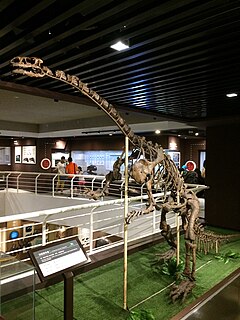
Lufengosaurus is a genus of massospondylid dinosaur which lived during the Early Jurassic period in what is now southwestern China. A nearly intact lufengosaurus was found in May 2021 in Lufeng City, in the Province of Yunnan, in Southern China, by paleontologists and Wang Tao, Head of the Dinosaur Conservation and Research Center in Lufeng City. Again, the dinosaur made international headlines in 2017 when Nature Communications reported scientists' discovery of 195-million-year-old collagen protein in the rib of a Lufengosarus fossil.
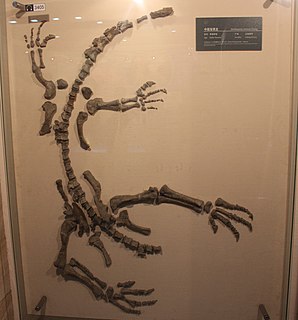
Gyposaurus is a genus of basal sauropodomorph dinosaur from the early Jurassic of South Africa. It is usually considered to represent juveniles of other prosauropods, but "G." sinensis is regarded as a possibly valid species.

Menemerus is a genus of jumping spiders that was first described by Eugène Louis Simon in 1868. They are 4 to 10 millimetres long, flattened in shape, and very hairy, usually with brown and grayish hairs. Most species have white edges on the thorax. The abdomen is often oval, or sometimes elongated or rounded.

The Celyphidae, commonly known as beetle flies or beetle-backed flies, are a family of flies. About 115 species in about 9 genera are known chiefly from the Oriental and Afrotropic biogeographic regions with one lineage in the New World.
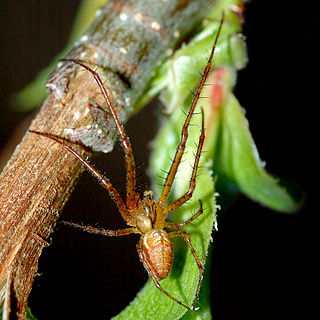
Metellina is a genus of tetragnathid spiders that occurs mostly in Eurasia, with two species found in North America. M. segmentata was introduced to Canada.
Vernaya is a genus of rodent in the subfamily Murinae from southern China and northern Burma. It contains a single extant species, the red climbing mouse, and several extinct species, all described by Zheng in 1993, namely Vernaya prefulva, Vernaya pristina, Vernaya giganta and Vernaya wushanica. The genus is named after Arthur Stannard Vernay who collected the specimen of V. fulva on an expedition to Burma with Charles Suydam Cutting.

Mesostigmata is an order of mites belonging to the Parasitiformes. They are by far the largest group of Parasitiformes, with over 8,000 species in 130 families. Mesostigmata includes parasitic as well as free-living and predatory forms. They can be recognized by the single pair of spiracles positioned laterally on the body.

The Mordellidae are a family of beetles commonly known as tumbling flower beetles for the typical irregular movements they make when escaping predators, or as pintail beetles due to their abdominal tip which aids them in performing these tumbling movements. Worldwide, there are about 1500 species.

Chalcosyrphus is a genus of hoverflies in the subfamily Eristalinae. Many species exhibit some degree of mimicry of various sawflies and other hymenopterans and are often brightly coloured or metallic in hue. The adults are similar in structure and behavior to the related genus Xylota but differ in larval morphology. They can be found throughout Europe, Asia, North America and South America and seem to prefer damper, boggy habitats. The larvae are saproxylic feeders in rotten wood in these habitats.
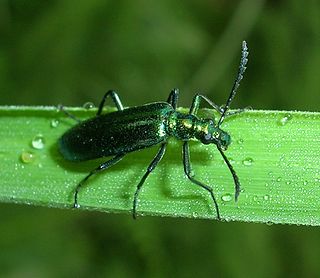
Prionoceridae is a small family of beetles, in the suborder Polyphaga. They form a group within the cleroid beetles and were formerly treated as a subfamily (Prionocerinae) within the family Melyridae. Very little is known of their life history but most species are pollen feeders as adults and occur in large numbers during spring or the host flowering season. Larvae are predatory or feed on decomposing wood.
Chodsigoa is a genus of shrews in the tribe Nectogalini.

Agonopterix is a moth genus of the superfamily Gelechioidea. It is placed in the family Depressariidae, which was often – particularly in older treatments – considered a subfamily of the Oecophoridae or included in the Elachistidae.

Apolygus spinolae is a species of true bug in the Miridae family. It can be found throughout Europe, except for Albania, Estonia, Liechtenstein, Malta, and Portugal. and not in the extreme south. Then east across the Palearctic to Siberia, and through Central Asia to China and Japan

Apolygus lucorum is a species of true bug in the Miridae family. It can be found everywhere in Europe except for Albania, Bulgaria, Iceland, Malta, and Portugal. and much of the Mediterranean basin, then east across the Palearctic to China and Japan.

The grand roundleaf bat, also known as the grand leaf-nosed bat, is a species of bat in the genus Hipposideros. It can be found in China, Myanmar, Thailand, and Vietnam.
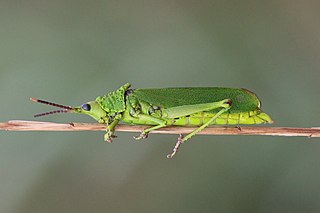
The Pyrgomorphinae are a sub-family of grasshoppers in the family Pyrgomorphidae. Species are found in, especially the warmer parts of: Central and South America, southern Europe, Africa, Asia, Australia and Pacific Islands. The type genus is Pyrgomorpha and names dates from "Pyrgomorphiden" by Brunner von Wattenwyl, 1874. The first use of Pyrgomorphinae was by Krauss in 1890.

Cryptochetum is a genus of scale parasite flies in the family Cryptochetidae. There are more than 30 described species in Cryptochetum.


















